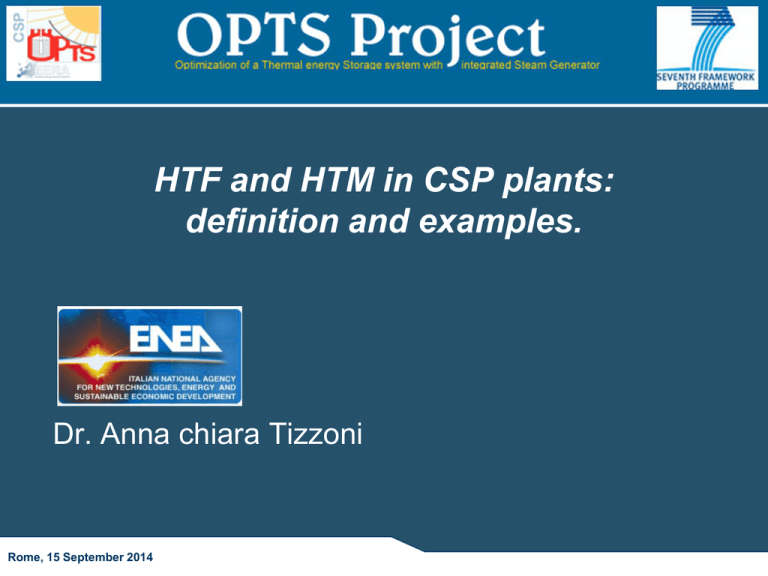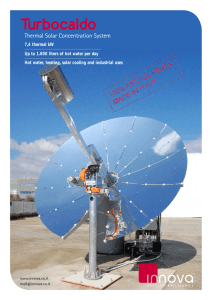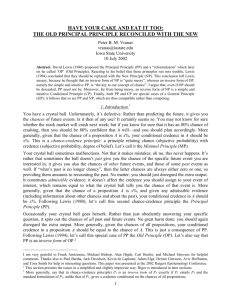OPTS_2_16_09_2014
advertisement

HTF and HTM in CSP plants: definition and examples. Dr. Anna chiara Tizzoni Rome, 15 September 2014 HTM and HSM • In parabolic trough solar plants (PTSP), a sun-orientable parabolic mirror is employed to concentrate solar energy on a fixed receiver pipeline containing a heat absorbing material (heat transfer fluid, HTF). • The thermal fluid transfers the energy to a heat storage tank, containing a heat storage material (HSM), which in turn will feed a steam generator to produce electric energy by, for instance, a Rankine cycle. 2 HTF and HTM Tube receivers Mixtures of molten salts (nitrates) have been extensively employed in various CSP plant typologies. In general, these materials can operate in a temperature range between 270 and 550600 °C 3 HTF and HTM HTM and HSM • Where the HTF and the HSM are the same material, there is no need of an intermediate heat exchanger (HX) between them. This configuration is employed by the ENEA developed plants and facilities, in particular, it is present in the Archimedes solar power plant located in the south eastern part of Sicily . • As expected, the thermal exchange and storage materials are fundamental components of a PTSP plant, affecting both the efficiency and the costs of the generated electric power. 4 HTF and HTM Diathermic oils • To date, most of the operating PTSPs employ diathermic oils as HTF, that are composed by a mixture of organic (generally aromatic) compounds, mostly diphenyl and diphenyl oxide. • Nitrate alkaline mixtures are generally used as HTMs. The heat transfer between the two fluids is performed by an intermediate HX. 5 HTF and HTM Diathermic oils - advantages • The main advantage in the employment of diathermic oils, is their low freezing point (-18÷12 °C), which avoids the HTF solidification in the plant receiver tube and pipelines; • In this way there is not the necessity for a heating system to maintain the plant lines at a temperature higher than the one in the external ambient. 6 HTF and HTM Diathermic oils - disadvantages • On the other hand, these materials are expensive, toxic for humans and very toxic for the environment, especially for the aquatic species; • They present a relatively low thermal stability, they can be employed up to about 250 °C at atmospheric pressure, and under pressure from nitrogen or inert gases up to around 440 °C. • Above this temperature they undergo an irreversible degradation and are also very flammable materials. 7 HTF and HTM State of art • Molten salts mixtures are known to exhibit satisfactory thermal and physical features, both for heat exchange and storage, in the temperature range concerned, together with low corrosion properties and a relatively low cost . Advantages of molten salts (nitrates/nitrites) : • safe • non-toxic • available at low cost • stable at relatively high temperatures 8 HTF and HTM Thermochemical properties of molten salts Solar Salt (NaNO3-KNO3 60-40 % w/w corresponding to 64/36 mol/mol) is currently the most employed material both as HTF and HSM. quite inexpensive not flammable presents a relatively high thermal stability point (≈ 600 °C) low viscosity high heat capacity the only drawback is a relatively high freezing point (238 °C) 9 HTF and HTM “Solar salt” properties Physical Properties : Phase Diagram NaNO3-KNO3 400 Freezing Temperature: 238°C; Melting point 350 Freezing point T (°C) 300 Melting Temperature: 221°C; 250 200 Heat of Fusion: 161 kJ/kg; 150 Molar Fraction NaNO3 1 0.9 0.8 0.7 0.6 0.5 0.4 0.3 0.2 0.1 0 100 Volume Change on Fusion: 4,6%. 10 HTF and HTM State of art – Solar Salt • It is clear that “solar salt” also presents several drawbacks. • A primary disadvantage is a relatively high freezing point ranging from about 100°C to 230°C, depending on the mixture's composition, as opposed to about 13°C for organic fluids. • As such, considerable attention must be paid to avoid salt freezing in the CSP plant, which can seriously affect the power plant's operating conditions, by plugging valves and pipes, and reducing heat transfer surface. 11 HTF and HTM Looking for new ones - reasons • It is possible to roughly estimate that the heat storage represents, in a typical CSP plant, from 10 to 20% of the total plant expenditure. • Considering that the cost of “low freezing” molten salts is about four times the cost of the solar salt mixture, it is possible to realistically estimate that, in case of “low freezing” molten salt mixtures used in place of the “solar salt mixture”, the expenditure related to heat storage will rise up to the 20-30% of the total plant cost. 12 HTF and HTM Looking for new ones • Also taking into account that the Rankine electric power generating block is slightly affected by a decrease of the lower operative point of the thermal fluids below 270 °C , the “solar salt” formulation can be considered the only realistic choice for heat storage in CSP applications; • Given its low cost, relatively high thermal stability and very low toxicity, it is also considered the most feasible material to be used as HTF. 13 HTF and HTM Low freezing mixtures • quaternary ones containing Na/K nitrates-nitrites, • ternary ones with lithium nitrate, could be advantageously employed as HTF so as to overcome the difficulties related to specific maintenance operations, such as shutting down and starting up plants. In the near future, the problems related to the employment of more innovative low melting molten salts can be investigated, and the improvement of their economical and chemicalphysical features is expected to be a very interesting and challenging research field. 14 HTF and HTM New mixtures • Besides diathermic oils and “solar salt”, other materials present some application as HTF: A commercial ternary mixture, produced by Coastal Chemical Co., L.L.C. and named Hitech® Heat Transfer Fluid, consists of NaNO3-KNO3-NaNO2, with a weight percentage ratio of 7/53/40 (see also table 2). The liquidus point was lowered to 141°C, and this material found a relatively wide application, but it suffered from a marked decrease in the material thermal stability, which is limited to 430° in air. Inert gases, however at an experimental stage, have also been used as solar heat thermal fluids. 15 HTF and HTM Advantages and disadvantages of the alternative HTFs employed 16 HTF and HTM New mixtures – on going • In recent times, also the addition of calcium nitrate Ca(NO3)2 and lithium nitrate LiNO3, together or separately, were also studied .The obtained ternary mixtures presented a liquidus point of 120 °C when lithium was added, and of 133 °C when calcium was added. • Regarding the thermal stability, if lithium nitrate is employed, the ternary material is stable up to 550 °C, but this value is limited below 500 °C if calcium nitrate is used, because at higher temperatures a solid phase is observed. 17 HTF and HTM New mixtures – on going • Furthermore, the addition of calcium nitrate leads to an increase of the mixture's viscosity, especially at temperatures near the freezing point . • Quaternary mixtures containing both calcium and lithium nitrates present very low melting points, but suffer the same problems of the ternary formulations containing lithium and calcium. 18 HTF and HTM New mixtures Liquidus T (°C) Max T (°C) notes 54 221 na eutettico 60 40 238 550-600 “solar salt” 7 53 141 450-538 “HITECH®” salt 15 42 140 505 AdP 18 53 30 120 550-600 Archetype 18 40 22 <95 na NaNO3 (%p) KNO3 (%p) 46 Ca(NO3) 2 (%p) LiNO3 (%p) NaNO2 (%p) 40 42 21 19 HTF and HTM Characterization steps in our labs STEPS to FOLLOW: Samples preparation mixed inside a glass flask heated up at around 300 °C mixed by mechanical stirring rapidly cooled down and mechanically crushed phase diagrams specific heat viscosity density Compared to Solar salt heat conductivity thermal stability XRD diffraction 20 HTF and HTM Characterization steps Properties Interest for HTF Interest for HSM phase diagrams Determination of the lowest Tliq Determination of the lowest Tliq specific heat Capacity of solar heat tranfer to the storage system Capacity of heat storage viscosity Determination of the necessary pumps hydraulic head It depends on the storage system. In“Archimede “configuration HTF and HSM are the same fluid. density Related to heat capacity; capability of heat storage per volume Related to heat capacity; capability of heat storage per volume heat conductivity Necessary parameter to determine the heat exchange surfaces Necessary parameter to determine the heat exchange surfaces thermal stability Maximum operative T Maximum operative T XRD diffraction Integration to investigate solid nitrates structures: predition for phase diagrams Integration to investigate solid nitrates structures: predition for phase diagrams 21 HTF and HTM Next future In the near future, problems related to the employment of more innovative low melting molten salts can be investigated, and the improvement of their economical and chemicalphysical features is expected to be a very interesting and challenging research field. 22 HTF and HTM









